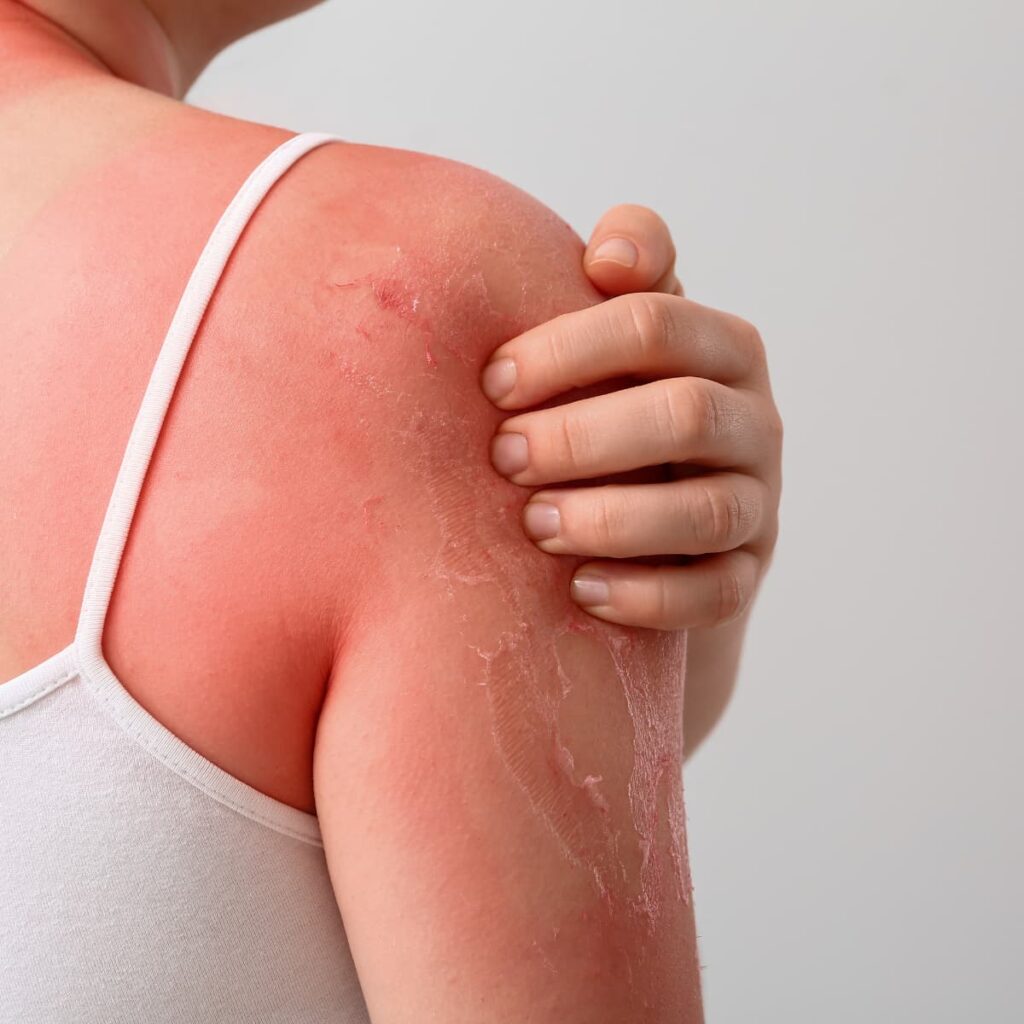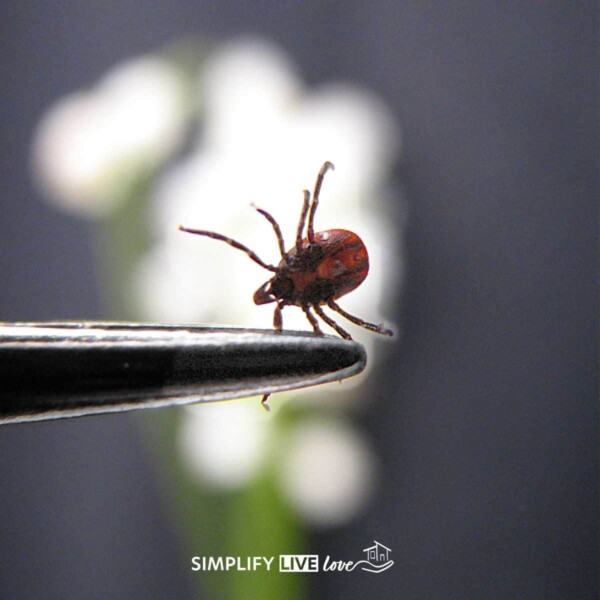Natural Sunburn Relief: 15 Home Remedies That Actually Work
on Apr 07, 2025
This post may contain affiliate links. Please read our disclosure policy.
Looking for natural sunburn relief that will actually work? As a fair-skinned, freckled strawberry blonde who’s experienced everything from mild redness to painful blisters, I understand the misery of sunburn firsthand. And as a mom of two redheaded girls, I’ve tried virtually every natural sunburn remedy available.
This comprehensive guide shares the most effective natural solutions for sunburn relief using ingredients you likely already have at home.

Quick Summary
Natural remedies like cool baths, aloe vera, and tea compresses provide effective sunburn relief without harsh chemicals. Prevention is always best, but these 15 home treatments can soothe pain, reduce inflammation, and speed healing when sunburn strikes.
🛡️ Prevention strategies help you avoid future sunburns altogether
🧊 Cooling treatments provide immediate pain relief and reduce inflammation
🌿 Plant-based remedies like aloe vera and chamomile tea offer natural healing properties
🥄 Kitchen staples such as apple cider vinegar and baking soda can effectively soothe sunburned skin
💧 Proper hydration speeds healing from both inside and out
Table of Contents
- Quick Summary
- Understanding Sunburns
- Prevention: Your First Defense
- Cooling Treatments for Immediate Sunburn Relief
- Plant-Based Sunburn Remedies
- Kitchen Remedies for Sunburn Relief
- Hydration & Internal Support for Sunburn Recovery
- Additional Sunburn Relief Strategies
- Recovery Timeline: What to Expect
- Frequently Asked Questions About Natural Sunburn Relief
- Save Your Skin: Start Your Natural Sunburn Relief Journey Today
Note: I am not a medical doctor, and this post should not be construed as medical advice. I am simply sharing natural sunburn relief methods that have worked for my family.
Understanding Sunburns
What Causes Painful Sunburns?
Sunburns happen when skin is overexposed to ultraviolet (UV) radiation from the sun. This exposure damages skin cells and triggers an inflammatory reaction as the body attempts to repair the damage.
Despite common belief, you can get sunburned on cloudy days, at high altitudes, or while spending extended periods in water – all situations where people often forget sun protection. This sun damage can affect the skin’s surface as well as deeper skin layers depending on exposure intensity.
Some medications can also increase sun sensitivity, including:
- Antibiotics (especially tetracyclines and fluoroquinolones)
- Retinoids
- Certain diabetes medications
- Some anti-inflammatories
- Many antidepressants and antipsychotics
Always check with your healthcare provider about potential photosensitivity if you’re taking any medications.
3 Types of Sunburns You Should Know
First-degree sunburn
These mild burns affect only the outer layer of skin (epidermis). Symptoms include:
- Red skin
- Mild pain or tenderness
- Slight swelling
- Skin that feels warm to the touch
Second-degree burns
This more serious burn affects both the epidermis and the layer beneath it (dermis). According to the American Academy of Dermatology, symptoms include:
- Intense redness
- Pain and tenderness
- Swelling
- Blistering
- Possible headache or mild fever
Third-degree sunburn (sun poisoning)
This severe condition requires immediate medical attention. Signs include:
- Severe blistering and swelling
- Headache, fever, and chills
- Nausea or vomiting
- Dizziness or confusion
- Dehydration
- Electrolyte imbalances
IMPORTANT: Third-degree sunburn is a medical emergency. Seek immediate medical attention if you experience these symptoms.
Prevention: Your First Defense
The most effective sunburn relief is avoiding sunburn altogether. Follow these prevention strategies:
Best Sunscreens for Natural Sun Protection
- Choose broad-spectrum sunscreens with SPF 30 or higher
- Look for mineral-based options with zinc oxide or titanium dioxide for sensitive skin
- Apply 20-30 minutes before sun exposure
- Reapply every 2 hours, or immediately after swimming or heavy sweating
- Use approximately 1 oz (a shot glass full) to cover affected areas
- Avoid direct sunlight during peak hours (10am-4pm), even with the best intentions
For reef-friendly options, consider checking the Environmental Working Group’s Sunscreen Guide for products ranked by safety and effectiveness.
Protective Clothing for Sunburn Prevention
- Consider sun-protective sleeves for activities like driving or gardening
- Wear UPF-rated clothing when possible
- Choose wide-brimmed hats (at least 3 inches all around)
- Invest in UV-blocking sunglasses to protect your eyes

Cooling Treatments for Immediate Sunburn Relief
1. Cool Bath Therapy for Sunburn Pain Relief
Ingredients needed: Cool water, optional additives
How it helps: Reduces skin temperature, soothes inflammation, and provides much-needed relief
Instructions:
- Fill a bathtub with cool bath water (avoid cold water as it can shock the system)
- Soak for 15-20 minutes
- Pat skin gently dry with a soft towel
- Apply a gentle moisturizer while skin is still slightly damp
According to the Mayo Clinic, taking a cool shower or bath is one of the best ways to immediately relieve sunburn pain.
Variations:
Colloidal Oatmeal Bath: Add 1 cup of colloidal oatmeal ground to a fine powder to soothe irritated skin and reduce itching
Baking Soda Bath: Add 1 cup of baking soda to neutralize acids on the skin and reduce inflammation
2. Cold Compress Treatment for Sunburned Skin
Ingredients needed: Clean cloth or towel, cool water
How it helps: Provides targeted relief to specific areas, reduces inflammation and pain
Instructions:
- Soak a clean cloth in cool water
- Wring out excess water
- Gently apply as a cool compress to sunburnt skin for 10-15 minutes
- Repeat as often as needed for pain relief
Pro tip: Use a soft cotton t-shirt or pillowcase rather than rough towels for extra comfort on sensitive skin. You can also use cold compresses or a wrapped ice pack (never apply ice directly) for additional cooling.
3. DIY Cooling Sprays for Sunburn Discomfort
Ingredients needed:
- 1 cup witch hazel (alcohol-free)
- 1 cup brewed green tea, cooled
- Optional: 5 drops peppermint essential oil for cooling sensation
How it helps: Provides cooling relief, reduces inflammation, and can be reapplied throughout the day
Instructions:
- Store in the refrigerator for up to one week
- Combine ingredients in a clean spray bottle
- Shake well before each use
- Spray lightly onto affected areas
- Allow to air dry

Plant-Based Sunburn Remedies
4. Aloe Vera: Nature’s Best Sunburn Treatment
Ingredients needed: Fresh aloe vera plant leaf or pure aloe vera gel
How it helps: Contains anti-inflammatory properties and antibacterial properties that reduce swelling, cool the skin, and promote the healing process

Instructions using a fresh plant:
- Cut a thick leaf from an aloe plant
- Slice open lengthwise
- Scoop out the clear gel with a spoon (or use a food processor for larger amounts)
- Apply directly to sunburned areas
- Reapply 2-3 times daily
Store-bought options: Look for products with at least 98% pure aloe vera and without artificial colors, fragrances, or alcohol. This gel form is a good option.
Pro tip: Store aloe gel in the refrigerator for extra cooling effect and relief.

5. Tea Treatments for Soothing Sunburned Skin
Ingredients needed: Black tea, green tea, or chamomile tea bags; water
How tea helps:
- Chamomile tea: Contains anti-inflammatory compounds and promotes relaxation
- Green tea: Rich in antioxidant properties that help repair skin damage
- Black tea: Contains tannic acid that helps restore skin’s pH balance and reduces inflammation
Instructions:
- Brew 3-4 tea bags in 2 cups of water
- Allow to cool completely (cooled tea works best)
- Apply using one of these methods:
- Soak clean cloths in tea and apply as compresses
- Pour cooled tea into a spray bottle and mist onto skin
- Add tea to a cool bath and soak
- Apply used, cooled tea bags directly to smaller affected areas
6. Essential Oils for Natural Sunburn Relief
Ingredients needed:
- Carrier oil (aloe vera gel or Vitamin E essential oil work best for sunburns)
- Essential oils such as lavender essential oil, chamomile, or tea tree essential oil
How they help: Provide anti-inflammatory and soothing properties while promoting skin healing
Good news: According to animal studies, certain essential oils can help reduce inflammation and support the healing process. When used properly, these oils are a valuable addition to your natural remedies arsenal for sunburn relief.
Instructions:
- Mix 1-2 drops of essential oil with 1 tablespoon of aloe vera gel
- Test on a small area first to ensure no irritation
- Gently apply to sunburned areas
- Reapply as needed
CAUTION: Always dilute essential oils properly. Never apply them directly to damaged skin.
Kitchen Remedies for Sunburn Relief
7. Apple Cider Vinegar for Sunburn Treatment
Ingredients needed: Apple cider vinegar (raw, unfiltered preferred), water
How it helps: The acetic acid acts as an astringent to balance skin pH, reduce inflammation, and relieve itching
Instructions:
- Dilute apple cider vinegar with equal parts water (never use full-strength as it may cause skin irritation)
- Apply using one of these methods:
- Soak clean cloths in the solution and apply as compresses
- Add 1 cup to a cool bath and soak for 20 minutes
- For small areas, dab gently with a cotton ball
Pro tip: Only use on intact skin (not on blisters or broken skin). White vinegar can also be used as an alternative home remedy for minor sunburn.
8. Witch Hazel: A Natural Astringent for Sunburn
Ingredients needed: alcohol-free witch hazel (alcohol-free is important!)
How it helps: Provides anti-inflammatory relief and helps reduce redness by constricting blood vessels near the surface of the skin
Instructions:
- Pour witch hazel onto a soft cotton pad or damp cloth
- Gently dab onto sunburned skin
- Allow to air dry
- Reapply as needed throughout the day
A board-certified dermatologist may recommend witch hazel as a gentle option for sunburn relief that won’t cause further damage to sensitive skin.
9. Baking Soda Baths and Pastes for Sunburn Relief
Ingredients needed: Baking soda, water
How it helps: Balances pH, reduces inflammation, and soothes itching
Bath method:
- Add 1 cup of baking soda to a cool bath
- Soak for 15-20 minutes
- Pat skin dry gently
Paste method for targeted relief:
- Mix 4 tablespoons of baking soda with enough water to form a paste
- Apply to affected areas for 10 minutes
- Rinse gently with cool water
Hydration & Internal Support for Sunburn Recovery
10. Hydration Methods for Healing Sunburns
Ingredients needed: Plenty of water, electrolyte drinks (optional)
How it helps: Sunburn draws fluid to the skin’s surface and away from the rest of the body, increasing dehydration risk. Proper hydration supports healing.
Daily hydration goals:
- Drink at least 8-10 glasses of water daily
- Increase intake by 2-4 glasses (extra water) when sunburned
- Monitor urine color (should be pale yellow)
- Consider sugar-free electrolyte drinks if experiencing headache or dizziness, especially with symptoms of sun poisoning
Pin this now to find it later
Pin It11. Foods That Speed Up Sunburn Healing
Key nutrients for skin repair:
- Vitamin E (almonds, avocados, sunflower seeds)
- Vitamin C (citrus fruits, bell peppers, strawberries)
- Omega-3 fatty acids (fatty fish, walnuts, flaxseeds)
- Zinc (pumpkin seeds, chickpeas, oysters)
- Vitamin D (in moderation, as your body may already be producing it from sun exposure)
Best foods with high water content:
- Cucumber (96% water)
- Watermelon (92% water)
- Strawberries (91% water)
- Cantaloupe (90% water)
- Peaches (89% water)
- Oranges (87% water)
- Plain yogurt (also contains beneficial lactic acid and probiotics)
12. Best Moisturizers for Sunburned Skin
When to apply: Only after skin has cooled completely to avoid trapping heat in the skin
Best ingredients to look for:
- Aloe vera
- Soy
- Vitamin E
- Hyaluronic acid
- Ceramides
- Coconut oil (only after skin has completely cooled)
Ingredients to avoid:
- Petroleum (can trap heat)
- Benzocaine or other “-caine” ingredients (can cause allergic reactions)
- Heavy fragrances that may cause skin irritation
- Alcohol-based products
- Hydrocortisone cream without medical advice (though it may be recommended by a doctor for specific cases)
Additional Sunburn Relief Strategies
13. Anti-inflammatory Support for Sunburn Pain
Over-the-counter options:
- Ibuprofen (reduces inflammation and pain)
- Naproxen (longer-lasting anti-inflammatory effects)
Natural alternatives:
- Turmeric (contains curcumin, a natural anti-inflammatory)
- Bromelain (enzyme found in pineapple that reduces swelling)
- Willow bark tea (contains natural salicylates)
14. Protective Aftercare for Healing Sunburns
Clothing considerations:
- Wear loose, breathable fabrics (cotton, linen)
- Choose seamless items to avoid friction
- Opt for UPF-rated clothing for continued sun protection
Environmental factors:
- Keep room temperatures cool
- Use fans for air circulation (avoid pointing directly at burns)
- Consider a humidifier to prevent excessive drying
15. Skin Recovery Support After Sunburn
Long-term skin health:
- Increase antioxidant intake
- Consider a vitamin D supplement (consult healthcare provider)
- Use gentle, fragrance-free products until fully healed
Post-sunburn skin treatments:
- Gentle exfoliation only after peeling has stopped
- Vitamin C serums to support collagen production
- Ceramide creams to restore skin barrier
Recovery Timeline: What to Expect
Days 1-2: Inflammation Phase
- Redness and warmth peak around 24 hours
- Pain is typically most intense – this is when painful sunburn is at its worst
- Focus on cooling, anti-inflammatory measures
- Watch for symptoms of sunburn that might indicate severe sunburns requiring medical care
Days 3-5: Healing Phase
- Pain begins to subside
- Peeling may begin as your body sheds damaged cells
- Transition to moisturizing focus to support the healing process
- Continue sun avoidance to prevent further damage to sensitive skin
- Watch for signs of infection which may require medical treatments
Days 6-10: Recovery Phase
- Peeling continues
- New skin is especially vulnerable to sun damage
- Maintain gentle care routine
- Use high SPF protection on newly healed skin
Beyond 10 Days: Long-term Care
- Monitor for any changes in skin appearance
- Consider professional skin check if you’ve had severe or multiple sunburns
- Implement preventative strategies consistently

Frequently Asked Questions About Natural Sunburn Relief
How long does a sunburn typically last?
Most mild to moderate sunburns (first-degree) will last 3-5 days. Second-degree sunburns with blistering can take 1-2 weeks to heal completely. The redness usually peaks around 24 hours after exposure, and peeling typically begins 3-8 days after getting burned.
Can I put ice directly on a sunburn?
No, never apply ice directly to a sunburn. Direct ice contact can damage already compromised skin and potentially cause an ice burn. Instead, use a cold compress made by wrapping ice in a thin towel or use cool water applications.
Which natural remedy works fastest for sunburn pain relief?
Cool baths or showers provide the most immediate relief for most people. For a targeted solution, aloe vera gel (especially refrigerated) offers quick pain relief due to its natural cooling properties and anti-inflammatory benefits.
Is it okay to exercise with a sunburn?
It’s best to avoid strenuous exercise with a significant sunburn. Exercise increases body temperature and blood flow to the skin, which can intensify pain and potentially delay healing. Sweating can also irritate sunburned skin and cause additional discomfort.
Does a sunburn turn into a tan?
Sometimes the body produces melanin (which causes tanning) in response to sun damage, but a sunburn itself doesn’t “turn into” a tan. Peeling removes the damaged skin cells, and what remains underneath may be slightly darker than your natural skin tone, but purposely burning to get a tan is extremely harmful to your skin.
Can I use makeup to cover a sunburn?
It’s best to avoid makeup on freshly sunburned skin, as it can irritate the damaged skin and potentially trap heat. Once the initial inflammation has subsided (after 24-48 hours), you can use mineral-based makeup if necessary, but giving your skin time to breathe and heal is ideal.
How can I tell if my sunburn requires medical attention?
Seek medical attention if you experience: severe blistering over a large portion of your body, facial swelling, fever over 101°F, chills, confusion, nausea or vomiting, rapid pulse or breathing, or signs of infection in blistered areas (increasing pain, swelling, warmth, or drainage).
Will drinking more water help heal my sunburn faster?
Yes, increasing your water intake helps with sunburn recovery. Sunburns draw fluid to the skin’s surface and away from the rest of the body, which can lead to dehydration. Proper hydration supports your body’s healing processes and helps maintain moisture in the damaged skin.
Does taking a hot shower help with sunburn?
No, hot water will intensify the burning sensation and can further damage sunburned skin. Always use cool or lukewarm water on sunburned areas until they’ve completely healed.
Can I pop sunburn blisters?
No, never pop sunburn blisters. They form to protect the damaged skin underneath and help prevent infection. Breaking blisters increases the risk of infection and can slow the healing process.
Does sunburn cause permanent damage?
Yes, each sunburn can cause permanent damage to skin cells and DNA. Multiple sunburns, especially those experienced during childhood and adolescence, significantly increase the risk of developing skin cancer later in life and contribute to premature aging and dark spots. According to the American Academy of Dermatology, having five or more sunburns doubles your lifetime risk of melanoma.
Save Your Skin: Start Your Natural Sunburn Relief Journey Today
Don’t wait until you’re suffering from a painful sunburn to prepare. Stock up on aloe vera, witch hazel, and other natural sunburn remedies so you’ll be ready at the first place sign of redness. Remember that prevention through protective clothing and sunscreen is always the best way to protect yourself in the first place, but having these home remedies on hand will help you bounce back faster when sunburn strikes despite your best intentions.













